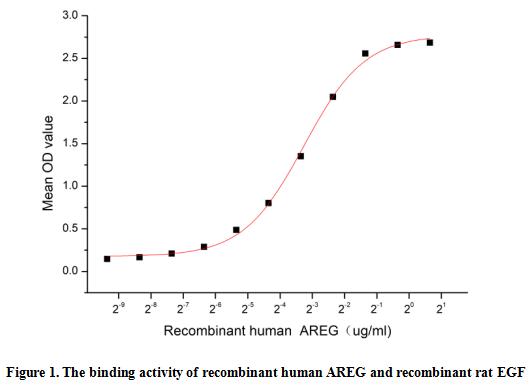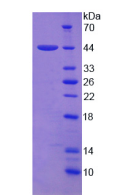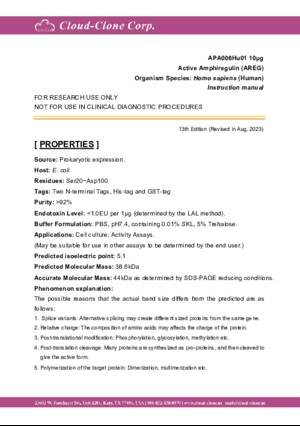Active Amphiregulin (AREG)
AR; CRDGF; SDGF; Colorectum Cell-Derived Growth Factor; Schwannoma-Derived Growth Factor
- Product No.APA006Hu01
- Organism SpeciesHomo sapiens (Human) Same name, Different species.
- Buffer FormulationPBS, pH7.4, containing 0.01% SKL, 5% Trehalose.
- Traits Freeze-dried powder
- Purity> 90%
- Isoelectric Point5.1
- ApplicationsCell culture; Activity Assays.
- DownloadInstruction Manual
- UOM 10µg50µg 200µg 1mg 5mg
- FOB
US$ 192
US$ 480
US$ 960
US$ 2880
US$ 7200
For more details, please contact local distributors!
ACTIVITY TEST

Amphiregulin (AREG) is a well-characterized member of the epidermal growth factor (EGF) family and is one of the ligands of the EGF receptor (EGFR). AREG plays a key role in mammalian development and in the control of branching morphogenesis in various organs. Furthermore, AREG participates in a wide range of physiological and pathological processes activating the major intracellular signalling cascades governing cell survival, proliferation and motility. Besides, EGF has been identified as an interactor of AREG, thus a functional binding ELISA assay was conducted to detect the interaction of recombinant human AREG and recombinant rat EGF. Briefly, AREG was diluted serially in PBS with 0.01% BSA (pH 7.4). Duplicate samples of 100 μl were then transferred to EGF-coated microtiter wells and incubated for 1h at 37℃. Wells were washed with PBST and incubated for 1h with anti-AREG pAb, then aspirated and washed 3 times. After incubation with HRP labelled secondary antibody for 1h at 37℃, wells were aspirated and washed 5 times. With the addition of substrate solution, wells were incubated 15-25 minutes at 37℃. Finally, add 50 µL stop solution to the wells and read at 450/630 nm immediately. The binding activity of recombinant human AREG and recombinant rat EGF was shown in Figure 1, the EC50 for this effect is 0.1 ug/mL.
USAGE
Reconstitute in 10mM PBS (pH7.4) to a concentration of 0.1-1.0 mg/mL. Do not vortex.
STORAGE
Avoid repeated freeze/thaw cycles. Store at 2-8°C for one month. Aliquot and store at -80°C for 12 months.
STABILITY
The thermal stability is described by the loss rate. The loss rate was determined by accelerated thermal degradation test, that is, incubate the protein at 37°C for 48h, and no obvious degradation and precipitation were observed. The loss rate is less than 5% within the expiration date under appropriate storage condition.
GIVEAWAYS
INCREMENT SERVICES
-
 BCA Protein Quantification Kit
BCA Protein Quantification Kit
-
 Molecular Mass Marker for Protein
Molecular Mass Marker for Protein
-
 Monoclonal Antibody Customized Service
Monoclonal Antibody Customized Service
-
 Polyclonal Antibody Customized Service
Polyclonal Antibody Customized Service
-
 Protein Activity Test Experiment Service
Protein Activity Test Experiment Service
-
 Electrophoretic Mobility Shift Assay (EMSA) Experiment Service
Electrophoretic Mobility Shift Assay (EMSA) Experiment Service
-
 Buffer
Buffer
-
 Lentivirus Packaging Experiment Service
Lentivirus Packaging Experiment Service
-
 Adenovirus Packaging Experiment Service
Adenovirus Packaging Experiment Service
-
 Real Time PCR Experimental Service
Real Time PCR Experimental Service
-
 Spike RBD Protein (S-RBD)
Spike RBD Protein (S-RBD)
-
 Protein G
Protein G
-
 Protein A
Protein A
| Magazine | Citations |
| Onkologie | Amphiregulin and Epiregulin Expression in Colorectal Carcinoma and the Correlation with Clinicopathological Characteristics Karger: 315380 |
| Br J Cancer. | Serum levels of hepatocyte growth factor and epiregulin are associated with the prognosis on anti-EGFR antibody treatment in KRAS wild-type metastatic colorectal cancer. Pubmed:24800946 |
| Cancer Sci | Association between serum ligands and the skin toxicity of anti-epidermal growth factor receptor antibody in metastatic colorectal cancer PubMed: 25707609 |
| J Cancer Res Clin Oncol | Amphiregulin confers trastuzumab resistance via AKT and ERK activation in HER2-positive breast cancer PubMed: 26195282 |
| Oncotarget. | Serum level of hepatocyte growth factor is a novel marker of predicting theoutcome and resistance to the treatment with trastuzumab in HER2-positive patients with metastatic gastric cancer Pubmed:26716644 |
| Acta Pharmacologica Sinica | Anti-asthmatic activity of alkaloid compounds from Pericarpium Citri Reticulatae (Citrus reticulata 'Chachi') Pubmed: 19363516 |
| International Journal of Biological Sciences | CD9 regulates keratinocyte migration by negatively modulating the sheddase activity of ADAM17 |
| Neoplasia | Patient-derived xenograft (PDX) models of colorectal carcinoma (CRC) as a platform for chemosensitivity and biomarker analysis in personalized medicine Pubmed: 33212364 |
| JOURNAL OF CELLULAR AND MOLECULAR MEDICINE | Polarization of ADAM17‐driven EGFR signalling in electric field‐guided collective migration of epidermal sheets Pubmed: 33164313 |
| Catalog No. | Related products for research use of Homo sapiens (Human) Organism species | Applications (RESEARCH USE ONLY!) |
| APA006Hu01 | Active Amphiregulin (AREG) | Cell culture; Activity Assays. |
| RPA006Hu01 | Recombinant Amphiregulin (AREG) | Positive Control; Immunogen; SDS-PAGE; WB. |
| PAA006Hu01 | Polyclonal Antibody to Amphiregulin (AREG) | WB; IHC; ICC; IP. |
| MAA006Hu23 | Monoclonal Antibody to Amphiregulin (AREG) | WB; IHC; ICC; IP. |
| MAA006Hu25 | Monoclonal Antibody to Amphiregulin (AREG) | WB; IHC; ICC; IP. |
| MAA006Hu22 | Monoclonal Antibody to Amphiregulin (AREG) | WB; IHC |
| MAA006Hu24 | Monoclonal Antibody to Amphiregulin (AREG) | WB; IHC; ICC/IF |
| MAA006Hu26 | Monoclonal Antibody to Amphiregulin (AREG) | WB; IHC |
| MAA006Hu21 | Monoclonal Antibody to Amphiregulin (AREG) | WB; IHC; ICC; IP. |
| MAA006Hu27 | Monoclonal Antibody to Amphiregulin (AREG) | WB; IHC; ICC; IP. |
| MAA006Hu29 | Monoclonal Antibody to Amphiregulin (AREG) | WB; IHC; ICC; IP. |
| LAA006Hu76 | Biotin-Linked Monoclonal Antibody to Amphiregulin (AREG) | WB; IHC; ICC. |
| SEA006Hu | ELISA Kit for Amphiregulin (AREG) | Enzyme-linked immunosorbent assay for Antigen Detection. |
| SCA006Hu | CLIA Kit for Amphiregulin (AREG) | Chemiluminescent immunoassay for Antigen Detection. |
| LMA006Hu | Multiplex Assay Kit for Amphiregulin (AREG) ,etc. by FLIA (Flow Luminescence Immunoassay) | FLIA Kit for Antigen Detection. |
| PSA006Hu01 | Antibody Pair for Amphiregulin (AREG) | ELISA; CLIA; ELISPOT; Luminex; Immunochromatography and other Immunoassays. |
| KSA006Hu01 | ELISA Kit DIY Materials for Amphiregulin (AREG) | Main materials for "Do It (ELISA Kit) Yourself". |








